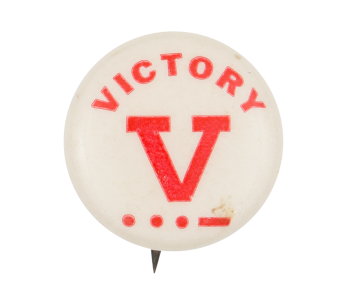| Category | |
|---|---|
| Additional Images | |
| Sub Categories | |
| Text on Button | VICTORY |
| Image Description | Red text on a white background |
| Back Style | |
| The Shape | |
| The Size | |
| Year / Decade Made | |
| Additional Information | World War II started in Europe in September 1939 when Germany invaded Poland. “V for Victory” came from Victor de Laveleye, a Belgian refugee, in January 1941. He broadcast that the letter V should become a resistance emblem standing for “Victoire,” victory in French. It also conveniently worked for “Vrijeid”, freedom in Dutch, and “Viktoria”, victory in German. People began scrawling V graffiti across occupied countries. Someone realized that the Morse Code symbol for V, dot dot dot dash, is the same rhythm as Beethoven's Fifth Symphony and the music became part of the victory movement. Winston Churchill publicly made the V symbol with his right hand. He spoke on the radio in June 1941 stating, ”The V sign is the symbol of the unconquerable will of the occupied territories and a portent of the fate awaiting Nazi tyranny. So long as the peoples continue to refuse all collaboration with the invader it is sure that his cause will perish and that Europe will be liberated.” America didn’t enter the war until December 8, 1941, but “V for Victory” was so pervasive that it was printed on envelopes and stationary in August, five months earlier. After the U.S. entered the war, the victory was reached, and this inspired airmail between military personnel and their relatives back home to become colloquially titled V-Mail. |
| Sources |
Zimmerman, D. (2011). The 'V for Victory' Campaign | Defense Media Network. Defense Media Network. from https://www.defensemedianetwork.com/stories/the-v-for-victory-campaign/. |
| Catalog ID | CA0506 |


